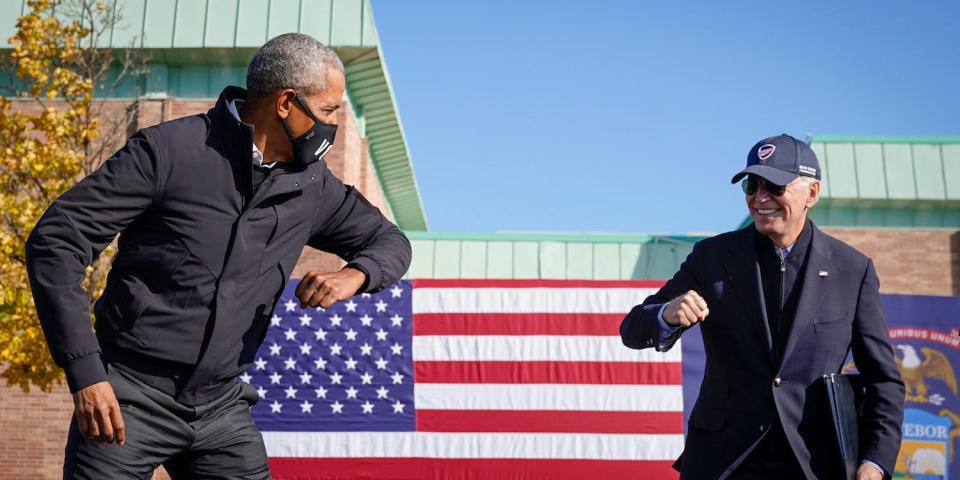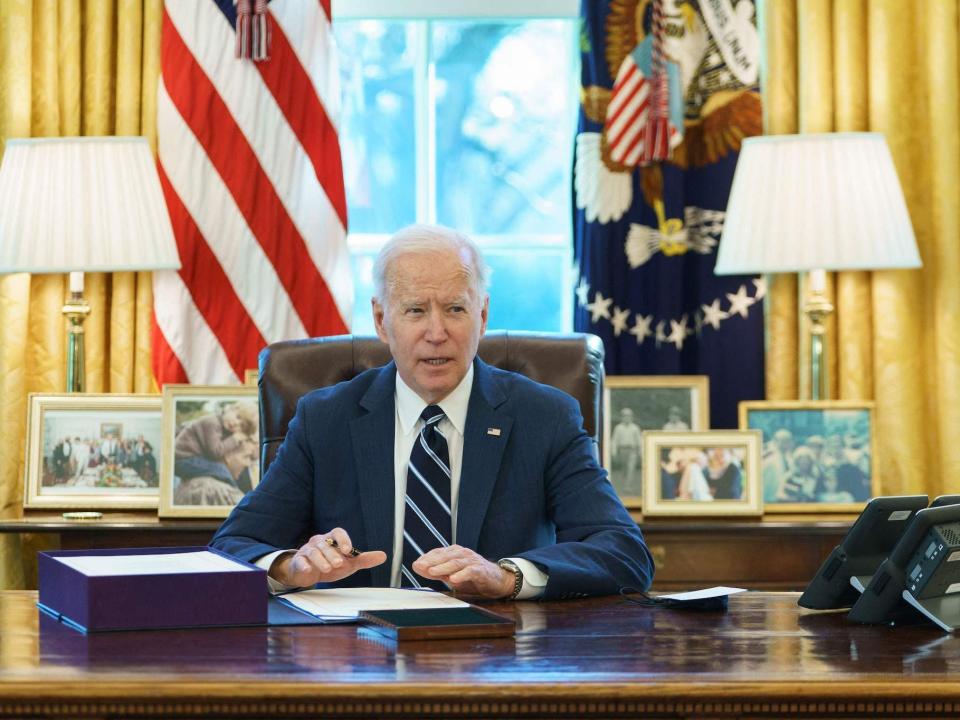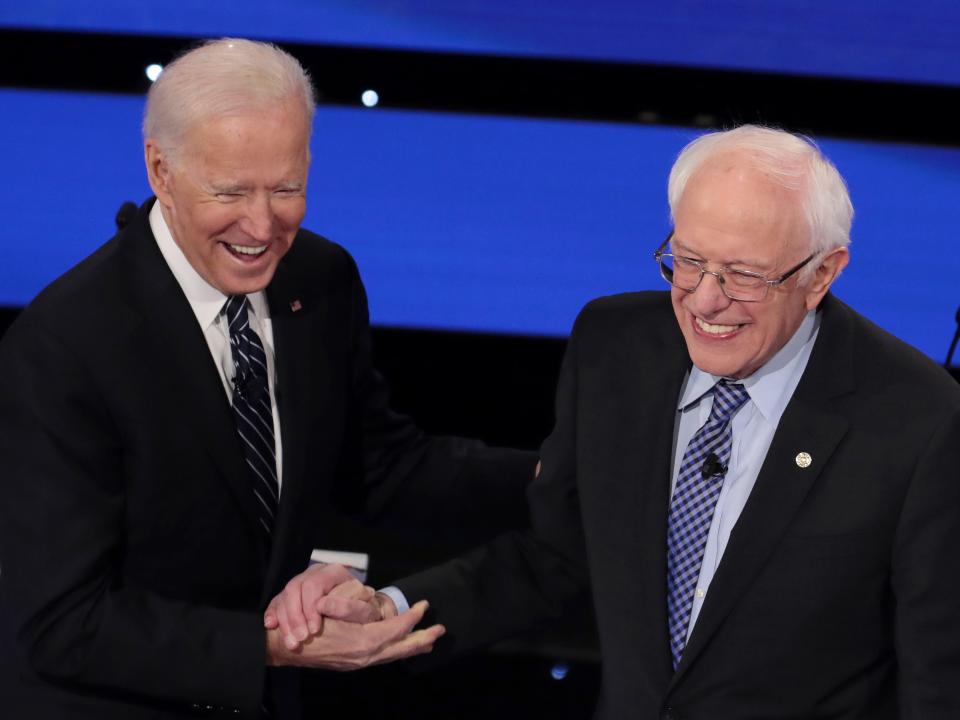Biden is splitting with Obama on the economy and the proof is in their stimulus plans

Biden's first economic package was bold in its size, breadth, and lack of bipartisanship.
It's a sharp contrast to the smaller package of the Obama era - and that era's slower recovery.
It shows Biden doesn't want to repeat that decade, and has an economic endgame in mind.
President Barack Obama and President Joe Biden faced similar circumstances in their first months in office. Both entered the White House in the midst of crippling economic downturns. Both immediately pursued emergency stimulus plans to put the country on track for a recovery. And both spent unprecedented amounts to do so.
But Biden is going bigger, and it could be a very big deal for the future of economic policy.
Biden came out swinging with his $1.9 trillion stimulus package, passed less than two months into his presidency. Beyond its size, scope, and speed, the plan signaled a major deviation from Obama-era logic on spending and working across party lines. The result was a wide-reaching package passed through reconciliation, one that picked up zero Republican votes in both the House and the Senate.
It showed that Biden doesn't plan to govern like Obama, where the aim was as much bipartisanship as possible and a mindfulness of the size of the federal debt. Biden's big spending has already evoked comparisons to FDR and LBJ - two presidents Axios reported Biden is very interested in these days - and he may just be getting started. The big question is what comes next.
"The recovery from the Great Recession was long and painful. It exacerbated inequality and other forms of economic scarring," Claudia Sahm, a former economist at the Federal Reserve, told Insider. "Those experiences are fresh in the minds of policymakers and the public."
Neither Obama's office nor the White House responded to requests for comment.
Recover first, pay the bill later
Congress' recession-recovery playbook has traditionally been fairly simple: offer support where needed, then pull back on aid and turn to austerity once the rebound is on track. Past downturns have seen calls for fiscal support quickly give way to deficit concerns among Republicans and Democrats.
But the record of recoveries from past downturns is informing Biden's approach. The Federal Reserve's decision to dampen inflation and start lifting interest rates in 2015 sparked years of weak growth and low inflation. Many economists have since looked back at the rate hikes and the Obama administration's stimulus package as allowing for a plodding economic rebound.
Biden aims to avoid the same pitfalls. The president has repeatedly expressed his desire to "go big" with relief spending, and, judging by his $1.9 trillion stimulus plan's popularity, Americans are on board. His strategy leans more on overfilling the hole in the economy than on prematurely closing the taps.
The very nature of the current slump changed the thinking around fiscal stimulus and paved the way for a new era of government support, said Jason Furman, professor of economics at Harvard University and chair of Obama's Council of Economic Advisors.
"When there is a big disaster like Katrina or the Gulf oil spill or superstorm Sandy, we'll spend $100 billion. This was like one of those disasters, but happening everywhere at the same time," Furman said. "People don't completely believe in fiscal stimulus. They do believe in disaster relief."

Congressional Democrats and Federal Reserve officials have been lining up alongside Biden. The rush to austerity in 2009 was a "big mistake" that left the country in recession for five years, Senate Majority Leader Chuck Schumer said in a March interview on CNN.
More recently, Federal Reserve Chair Jerome Powell told NPR that the economic recovery still takes priority over the national debt. While the country's spending path is currently unsustainable, low rates ensure it can pay off its debt until the economic activity fully rebounds.
The government will eventually have to put the federal debt on a sustainable path, "but that time is not now," the Fed chair added.
The central bank is still projecting its first rate hike won't arrive until after 2023, and officials have hinted they aren't even considering pulling back on the Fed's emergency asset purchases. Rising Treasury yields suggest investors have different expectations, but policymakers have so far been steadfast in their patience.
"If my 2010 self could see just how different we're handling this recovery than we handled that one - when we were just pulling our hair out, because Congress was turning towards austerity when the unemployment rate was literally over 9% - it was just an outrageous approach to the recovery at that time," Heidi Shierholz, director of policy at the left-leaning Economic Policy Institute and former chief economist to Obama's secretary of Labor, told Insider. "And so this is just incredibly different."
A lack of state and local spending hindered Obama's recovery, but Biden is pouring in billions
Economists began to sound the alarm before the second stimulus, emphasizing the urgent need for state and local funding. As Insider's Ben Winck and Joseph Zeballos-Roig reported at the time, the CARES Act's $150 billion for local governments ran out on December 30 - and the lack of similar funds in the Great Recession likely slowed the subsequent recovery. That funding was also scrapped in former President Donald Trump's second stimulus package; as CNN reported.

But Biden's $350 billion in state and local aid will prove hugely consequential for cities like New York, which was uniquely pummeled by the pandemic. It was a measure supported and championed by every elected Democratic state treasurer.
It's also the largest ever investment from the government in Native communities.
Biden's next major package looks like it will be even bigger. Coming in two parts, the first focusing on physical infrastructure, like roads and bridges, and the second on human infrastructure, like education and childcare, it is expected to cost around $3 trillion.
Biden is embracing his new role as FDR-adjacent
When it comes to his legacy, Biden is reportedly excited about what's forming. Axios reported that he recently met with presidential historians to discuss the size and speed of potentially huge changes, with comparisons abounding to Presidents Franklin Delano Roosevelt and Lyndon Baines Johnson, who both spearheaded huge expansions of the social safety net.
"The historians' views were very much in sync with his own: It is time to go even bigger and faster than anyone expected. If that means chucking the filibuster and bipartisanship, so be it," Axios' Mike Allen and Jim VandeHei wrote. In fact, they report, Biden loves the narrative that he's thinking bigger and bolder than Obama.
He's even gotten praise from another longtime politician and Senate veteran: Progressive figurehead Bernie Sanders. In an interview with The New York Times' Ezra Klein, Sanders praised Biden for moving past his more "moderate" past and "acting boldly" with the American Rescue Plan.

Sanders expressed optimism to Klein, but noted many progressive initiatives remain unfulfilled, such as student debt forgiveness and an increase to the federal minimum wage.
Leonard Burman, the Paul Volcker Chair of Behavioral Economics at Syracuse University's Maxwell School, told Insider that the Great Depression actually lasted as long as it did because Roosevelt and other leaders feared deficits too much.
FDR actually spent less than would have been "appropriate," Burman said, and recovery really only came with the influx of spending that accompanied World War Two.
"People think of the New Deal as this really, really aggressive response to the Great Depression," said Burman, who is also cofounder of the Urban Institute's Tax Policy Center, and he said it limited pain by creating jobs for some people that needed them and providing other assistance, "but it was way too small. So we literally have now - as far as I know - we've never done this."
"We have lots of experience with spending too little to try to get out of a recession. We don't have any experience with spending too much," Burman said. "So it'll be interesting to see what happens."
Rampant inflation is the new debt scare
Concerns around a surging government debt pile held back Obama's stimulus in 2009. Today, the argument looming over Biden and his spending plans has to do with inflation. Specifically, whether all the money Biden is pushing into the economic recovery will fuel a big comeback or instead spark stifling hyperinflation.
The Fed is behind the push for stronger-than-usual price growth. The central bank updated its policy framework in August to target inflation that averages 2% over time, as opposed to the prior goal of simply pursuing 2% inflation.
Officials have since confirmed that, at least for a period after the pandemic, the Fed aims to let inflation trend above 2% to counter years of weak price growth, underscoring just how different the approach is this time around.

The Obama administration "had a hard time" getting some Democratic senators to lift the debt limit and spend roughly $831 billion on the American Recovery and Reinvestment Act, Furman told Insider.
The Biden administration, on the other hand, has had a far easier time uniting Democrats around trillions of dollars worth of relief spending.
"The inflation debate is largely taking place among economists. It's not a concern that I've heard very much from members of Congress," Furman said. "Biden benefits from people having much more tolerance for larger numbers than they used to."
Biden and the Fed both want an equitable labor market
Going hand in hand with the Fed's new inflation target is a goal to pursue "maximum" employment instead of its previous mandate of "full" employment. The updated strategy leans more on using a range of indicators to judge the labor market's health than focusing on the headline unemployment rate.
Though the central bank acts independently of the White House, the new framework opens the door to economic policy that more aggressively targets a tighter and more equitable labor market.
"There was a time when there was a tight connection between unemployment and inflation. That time is long gone," Fed Chair Powell said during a March 17 press conference. "We had low unemployment in 2018 and 2019 and the beginning of '20 without having troubling inflation at all."
Job gains seen at the end of the last economic expansion largely benefited racial minorities and lower-income Americans, two groups that underperformed the broader unemployment rate for years. Biden's latest stimulus plan stands to lift demand and pull forward such gains. The millions of jobs still lost to the pandemic indicate there's plenty of slack in the economy and, therefore, reason to supercharge growth with fiscal support, UBS economists said in a March 9 note.
That slack also supports calls for additional large-scale spending packages. The $3 trillion in new spending is still not enough to get the US economy to the finish line, Sahm told Insider.
"Both the 2001 and 2008 recession were jobless recoveries, in that GDP got back on track much sooner than employment," she said. "A year into the pandemic, we are still missing 9.5 million jobs relative to pre-pandemic. We cannot afford to have another jobless recovery."
It's becoming clear just two months into his presidency that Biden has an endgame in sight: lots of government spending to create a more equitable economy.
Read the original article on Business Insider

 Yahoo News
Yahoo News 